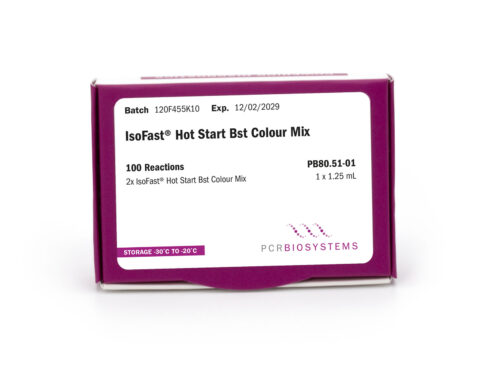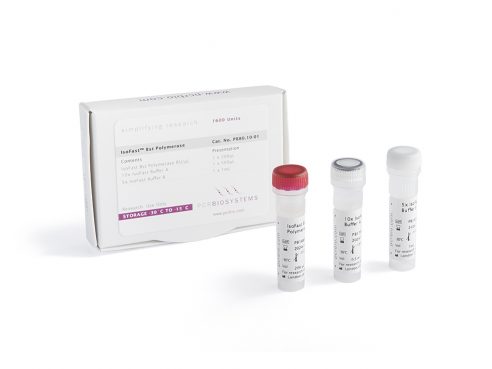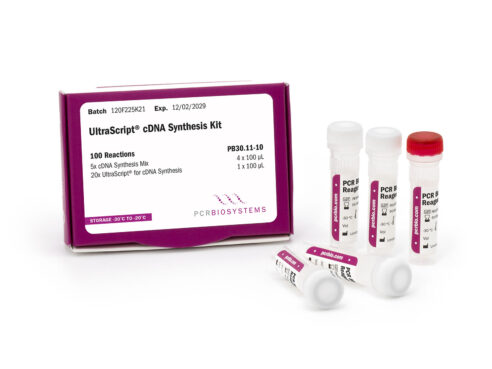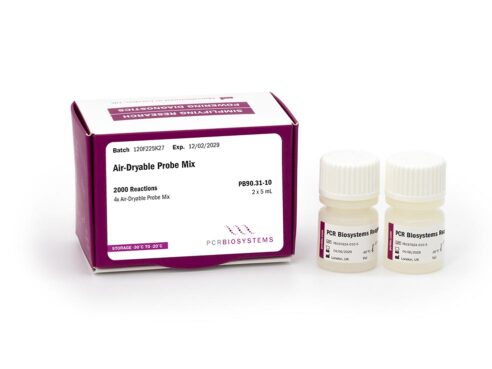IsoFast® Hot Start Bst Polymerase & Mixes
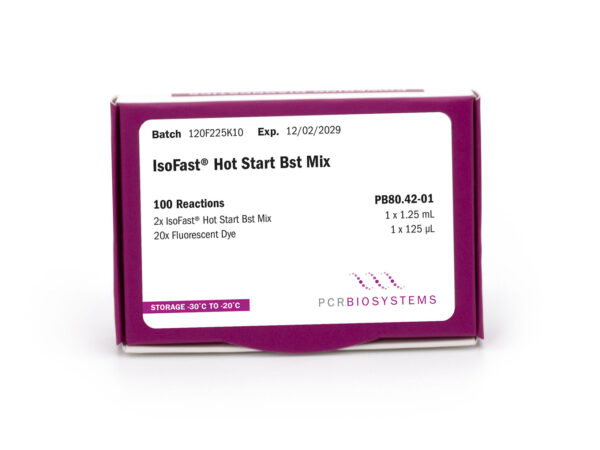
Bst DNA polymerase combined with AptaLock™ reversible hot-start technology power our IsoFast® Hot Start Bst reagents. These products are ideal for all isothermal amplification workflows, giving more sensitive and reliable results faster than ever before.
IsoFast® Hot Start Bst Polymerase is a recombinant version of the large fragment of Geobacillus stearothermophilus (formerly known as Bacillus stearothermophilus, Bst) DNA Polymerase. It is engineered to retain 5’-3’ polymerase activity, but lacks 5’-3’ exonuclease activity. The enzyme’s strong strand displacement capability eliminates the need for denaturation required by standard PCR. Combined with powerful hot start technology, to minimise primer dimer formation and non-specific target amplification, this novel formulation is ideal for non-PCR based amplification
IsoFast® Hot Start Bst Polymerase & Mix are the most recent and improved development of isothermal amplification technology, designed to deliver unparalleled specificity and speed. Whether you are working with loop-mediated isothermal amplification (LAMP) or other isothermal amplification methods, IsoFast® Hot Start Bst reagents guarantee exceptional sensitivity and reliability. Our reagents harness the power of a hot start Bst DNA polymerase enzyme, which ensures minimal background amplification and maximises target specificity. With IsoFast® Hot Start, your isothermal amplification experiments will be faster, more efficient, and easier than ever in both diagnostic and research applications.
Features
- AptaLock™ hot start for ultra-sensitive detection of DNA targets
- Rapid polymerisation for faster time to results (as little as 10 mins)
- Detect down to 3 target copies per μL
- Ideal for both cold and room temperature setup
- Improved speed and sensitivity for early target detection
- High activity at a broad range of temperatures from 55-70
- Available with and without fluorescent dye, and as a 2x ready mix
- Formats available for colourimetric assays.
Applications
- Whole genome amplification
- Multiple displacement amplification
- Rolling circle amplification
- Isothermal amplification
- Loop mediated isothermal amplification (LAMP)
- Molecular diagnostics
- Point-of-care testing
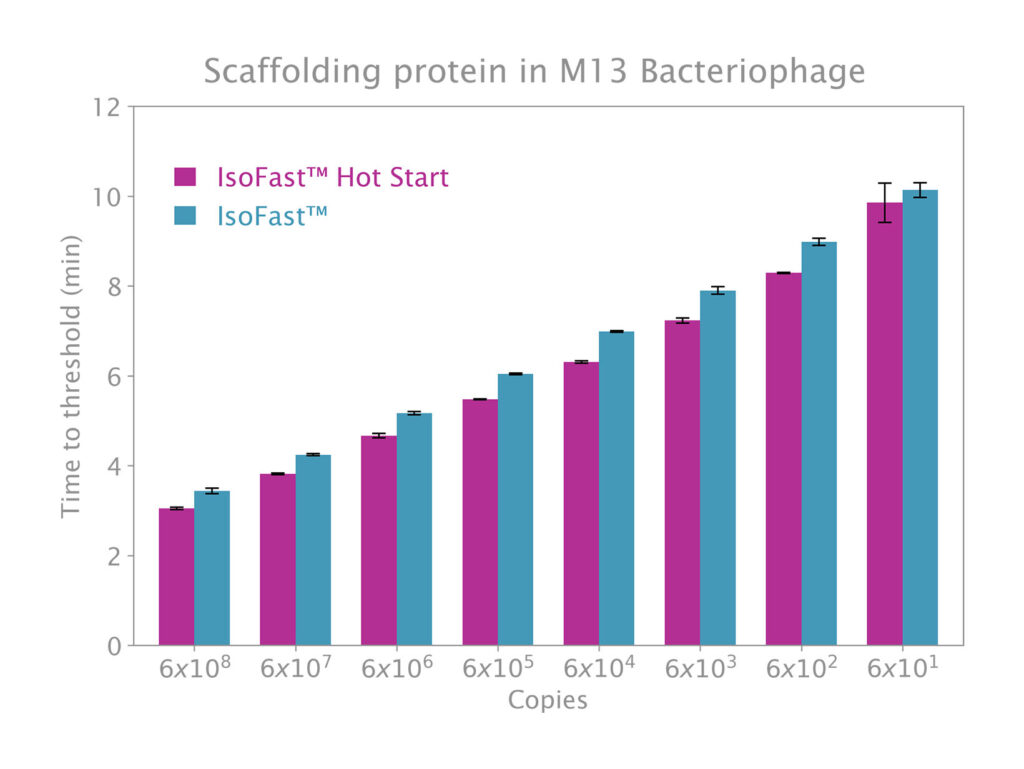
Hot start isothermal amplification
Hot start is important in isothermal amplification techniques because it helps to prevent non-specific amplification and false-positive results. Isothermal amplification methods, such as loop-mediated isothermal amplification (LAMP), rely on specific primers and enzymes to amplify a target sequence at a constant temperature, typically between 60°C and 65°C. These techniques are widely used in various applications, including molecular diagnostics and pathogen detection.
Why is hot start crucial in isothermal amplification?
- Preventing non-specific amplification in Bst polymerase isothermal reactions: In isothermal amplification, it’s essential to ensure that the amplification process only targets the specific sequence of interest. Non-specific amplification can occur when primers bind to unintended regions of the template or when amplification enzymes prematurely initiate amplification. Hot start techniques involve inhibiting the amplification reaction until the reaction reaches the desired temperature. This prevents the formation of non-specific products during the initial stages of the reaction when the temperature is still below the optimal amplification temperature.
- Enhancing Bst polymerase isothermal amplification specificity: By preventing premature amplification, hot start methods increase the specificity of the isothermal amplification reaction. This means that the reaction is less likely to amplify non-target sequences, reducing the risk of false-positive results.
- Improving isothermal amplification sensitivity with Bst polymerase: Hot start techniques can also improve the sensitivity of isothermal amplification assays. By minimising non-specific amplification, more of the available reagents are reserved for amplifying the target sequence, increasing the efficiency of the reaction and the detection limit.
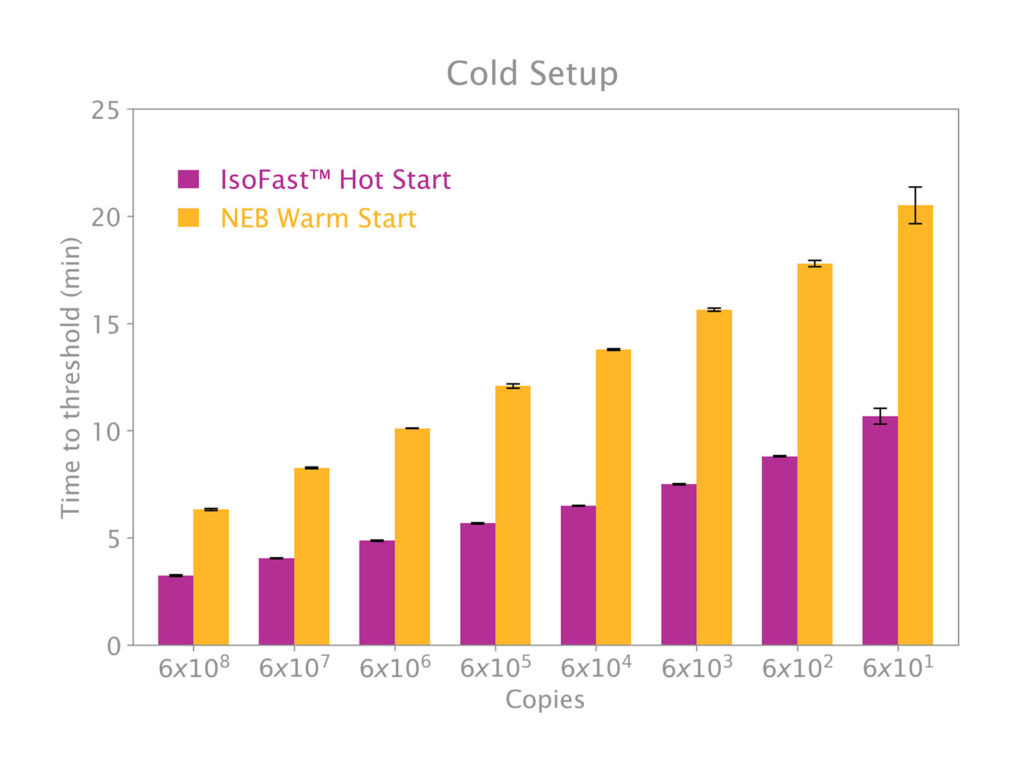
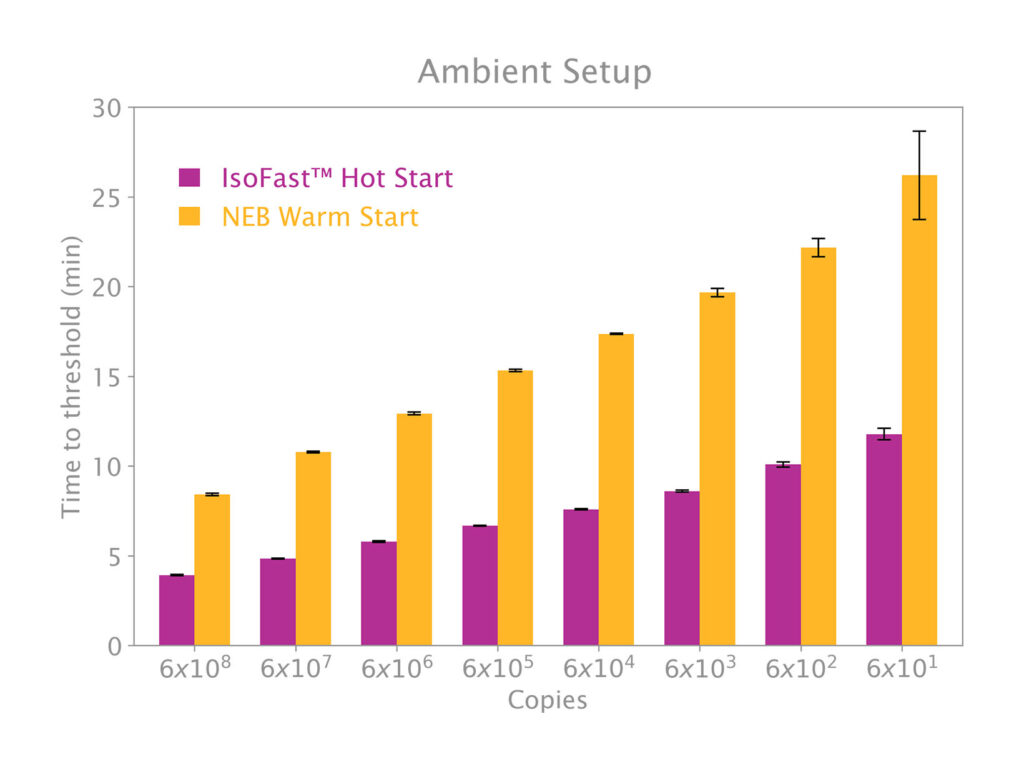
Documents
Product Flyers
Product Manuals
Material Safety Data Sheets
Certificate of Analysis Finder
Specifications
IsoFast® Hot Start Bst Polymerase
Component
1600 Units
8000 Units
IsoFast Hot Start Bst Polymerase 8 U/μL
1 x 200 μL
1 x 1 mL
10x IsoFast Buffer A
1 x 500 μL
2 x 1.25 mL
5x IsoFast Buffer B
1 x 1 mL
3 x 1.7 mL
IsoFast® Hot Start Bst Polymerase with Dye
Component
1600 Units
8000 Units
IsoFast Hot Start Bst Polymerase 8 U/μL
1 x 200 μL
1 x 1 mL
10x IsoFast Buffer A
1 x 500 μL
2 x 1.25 mL
5x IsoFast Buffer B
1 x 1 mL
3 x 1.7 mL
20x Fluorescent Dye
2 x 125 μL
2 x 625 μL
IsoFast® Hot Start Bst Mix
Component
100 Reactions
500 Reactions
2x IsoFast Hot Start Bst Mix
1 x 1.25 mL
5 x 1.25 mL
20x Fluorescent Dye
1 x 125 μL
1 x 625 μL
IsoFast® Hot Start Bst Polymerase
Component
IsoFast Hot Start Bst Polymerase 8 U/μL
10x IsoFast Buffer A
5x IsoFast Buffer B
1600 Units
1 x 200 μL
1 x 500 μL
1 x 1 mL
8000 Units
1 x 1 mL
2 x 1.25 mL
3 x 1.7 mL
IsoFast® Hot Start Bst Polymerase with Dye
Component
IsoFast Hot Start Bst Polymerase 8 U/μL
10x IsoFast Buffer A
5x IsoFast Buffer B
20x Fluorescent Dye
1600 Units
1 x 200 μL
1 x 500 μL
1 x 1 mL
2 x 125 μL
8000 Units
1 x 1 mL
2 x 1.25 mL
3 x 1.7 mL
2 x 625 μL
IsoFast® Hot Start Bst Mix
Component
2x IsoFast Hot Start Bst Mix
20x Fluorescent Dye
100 Reactions
1 x 1.25 mL
1 x 125 μL
500 Reactions
5 x 1.25 mL
1 x 625 μL
Reaction Volume
Storage
25 μL
On arrival, products should be stored between -30 and -20 °C. If stored correctly the kit will retain full until the indicated expiry date.
Reaction Volume
25 μL
Storage
On arrival, products should be stored between -30 and -20 °C. If stored correctly the kit will retain full until the indicated expiry date.
FAQs
Can I use products amplified with IsoFast® Hot Start Bst reagents in downstream applications, such as cloning or sequencing?
Certain types of isothermal amplification strategies lend themselves to downstream applications, e.g. RCA (rolling circle amplification) or WGA (whole genome amplification) for NGS. IsoFast® Hot Start Bst reagents can be used for this type of amplification. However, the most common type of isothermal amplification, LAMP, generates multiple species of DNA products, making it unsuitable for cloning and impractical for NGS applications.
What type of nucleic acid can I amplify with IsoFast® Hot Start Bst reagents?
IsoFast® Hot Start Bst Polymerase, IsoFast® Hot Start Bst Mix, IsoFast® Hot Start Bst Colour Mix, and IsoFast® Hot Start Bst Polymerase Colour are all designed for amplification of DNA and cDNA targets. They are not suitable for direct amplification of RNA targets.
In order to amplify RNA targets, we recommend using our IsoFast® Bst 1-Step Mix, for direct 1-step isothermal amplification. Alternatively, we suggest a 2-step format, where RNA is converted to cDNA using one of our UltraScript® reagents, followed by amplification of cDNA with the users’ preferred IsoFast® Hot Start Bst reagent.
IsoFast® Hot Start Bst Polymerase & Mix are the most recent and improved development of isothermal amplification technology, designed to deliver unparalleled specificity and speed. Whether you are working with loop-mediated isothermal amplification (LAMP) or other isothermal amplification methods, IsoFast® Hot Start Bst reagents guarantee exceptional sensitivity and reliability. Our reagents harness the power of a hot start Bst DNA polymerase enzyme, which ensures minimal background amplification and maximises target specificity. With IsoFast® Hot Start, your isothermal amplification experiments will be faster, more efficient, and easier than ever in both diagnostic and research applications.
Features
- AptaLock™ hot start for ultra-sensitive detection of DNA targets
- Rapid polymerisation for faster time to results (as little as 10 mins)
- Detect down to 3 target copies per μL
- Ideal for both cold and room temperature setup
- Improved speed and sensitivity for early target detection
- High activity at a broad range of temperatures from 55-70
- Available with and without fluorescent dye, and as a 2x ready mix
- Formats available for colourimetric assays.
Applications
- Whole genome amplification
- Multiple displacement amplification
- Rolling circle amplification
- Isothermal amplification
- Loop mediated isothermal amplification (LAMP)
- Molecular diagnostics
- Point-of-care testing

Hot start isothermal amplification
Hot start is important in isothermal amplification techniques because it helps to prevent non-specific amplification and false-positive results. Isothermal amplification methods, such as loop-mediated isothermal amplification (LAMP), rely on specific primers and enzymes to amplify a target sequence at a constant temperature, typically between 60°C and 65°C. These techniques are widely used in various applications, including molecular diagnostics and pathogen detection.
Why is hot start crucial in isothermal amplification?
- Preventing non-specific amplification in Bst polymerase isothermal reactions: In isothermal amplification, it’s essential to ensure that the amplification process only targets the specific sequence of interest. Non-specific amplification can occur when primers bind to unintended regions of the template or when amplification enzymes prematurely initiate amplification. Hot start techniques involve inhibiting the amplification reaction until the reaction reaches the desired temperature. This prevents the formation of non-specific products during the initial stages of the reaction when the temperature is still below the optimal amplification temperature.
- Enhancing Bst polymerase isothermal amplification specificity: By preventing premature amplification, hot start methods increase the specificity of the isothermal amplification reaction. This means that the reaction is less likely to amplify non-target sequences, reducing the risk of false-positive results.
- Improving isothermal amplification sensitivity with Bst polymerase: Hot start techniques can also improve the sensitivity of isothermal amplification assays. By minimising non-specific amplification, more of the available reagents are reserved for amplifying the target sequence, increasing the efficiency of the reaction and the detection limit.


Request a Quote & Sample
Your Selection:
Documents
Product Flyers
Product Manuals
Material Safety Data Sheets
Certificate of Analysis Finder
Specifications
IsoFast® Hot Start Bst Polymerase
Component
1600 Units
8000 Units
IsoFast Hot Start Bst Polymerase 8 U/μL
1 x 200 μL
1 x 1 mL
10x IsoFast Buffer A
1 x 500 μL
2 x 1.25 mL
5x IsoFast Buffer B
1 x 1 mL
3 x 1.7 mL
IsoFast® Hot Start Bst Polymerase with Dye
Component
1600 Units
8000 Units
IsoFast Hot Start Bst Polymerase 8 U/μL
1 x 200 μL
1 x 1 mL
10x IsoFast Buffer A
1 x 500 μL
2 x 1.25 mL
5x IsoFast Buffer B
1 x 1 mL
3 x 1.7 mL
20x Fluorescent Dye
2 x 125 μL
2 x 625 μL
IsoFast® Hot Start Bst Mix
Component
100 Reactions
500 Reactions
2x IsoFast Hot Start Bst Mix
1 x 1.25 mL
5 x 1.25 mL
20x Fluorescent Dye
1 x 125 μL
1 x 625 μL
IsoFast® Hot Start Bst Polymerase
Component
IsoFast Hot Start Bst Polymerase 8 U/μL
10x IsoFast Buffer A
5x IsoFast Buffer B
1600 Units
1 x 200 μL
1 x 500 μL
1 x 1 mL
8000 Units
1 x 1 mL
2 x 1.25 mL
3 x 1.7 mL
IsoFast® Hot Start Bst Polymerase with Dye
Component
IsoFast Hot Start Bst Polymerase 8 U/μL
10x IsoFast Buffer A
5x IsoFast Buffer B
20x Fluorescent Dye
1600 Units
1 x 200 μL
1 x 500 μL
1 x 1 mL
2 x 125 μL
8000 Units
1 x 1 mL
2 x 1.25 mL
3 x 1.7 mL
2 x 625 μL
IsoFast® Hot Start Bst Mix
Component
2x IsoFast Hot Start Bst Mix
20x Fluorescent Dye
100 Reactions
1 x 1.25 mL
1 x 125 μL
500 Reactions
5 x 1.25 mL
1 x 625 μL
Reaction Volume
Storage
25 μL
On arrival, products should be stored between -30 and -20 °C. If stored correctly the kit will retain full until the indicated expiry date.
Reaction Volume
25 μL
Storage
On arrival, products should be stored between -30 and -20 °C. If stored correctly the kit will retain full until the indicated expiry date.
FAQs
Can I use products amplified with IsoFast® Hot Start Bst reagents in downstream applications, such as cloning or sequencing?
Certain types of isothermal amplification strategies lend themselves to downstream applications, e.g. RCA (rolling circle amplification) or WGA (whole genome amplification) for NGS. IsoFast® Hot Start Bst reagents can be used for this type of amplification. However, the most common type of isothermal amplification, LAMP, generates multiple species of DNA products, making it unsuitable for cloning and impractical for NGS applications.
What type of nucleic acid can I amplify with IsoFast® Hot Start Bst reagents?
IsoFast® Hot Start Bst Polymerase, IsoFast® Hot Start Bst Mix, IsoFast® Hot Start Bst Colour Mix, and IsoFast® Hot Start Bst Polymerase Colour are all designed for amplification of DNA and cDNA targets. They are not suitable for direct amplification of RNA targets.
In order to amplify RNA targets, we recommend using our IsoFast® Bst 1-Step Mix, for direct 1-step isothermal amplification. Alternatively, we suggest a 2-step format, where RNA is converted to cDNA using one of our UltraScript® reagents, followed by amplification of cDNA with the users’ preferred IsoFast® Hot Start Bst reagent.




